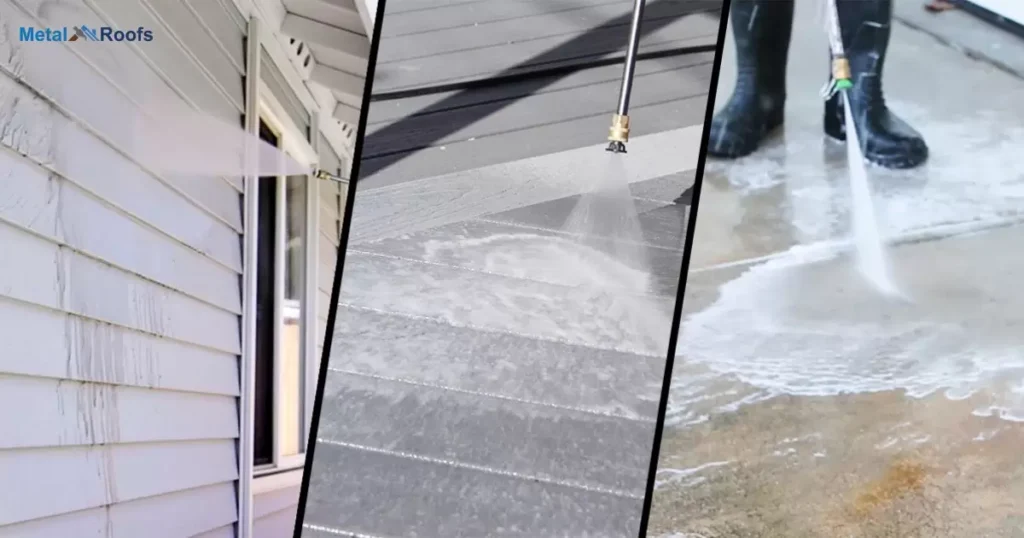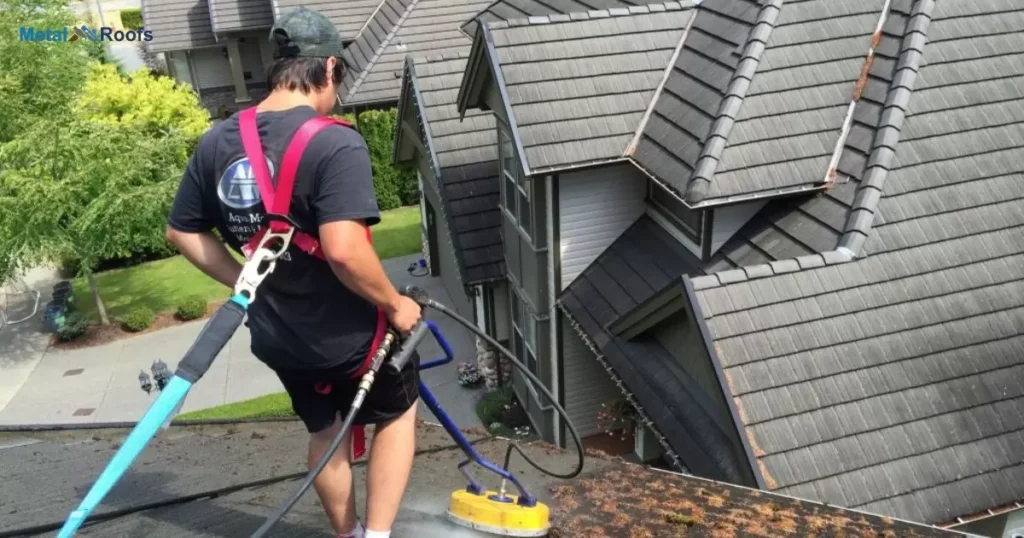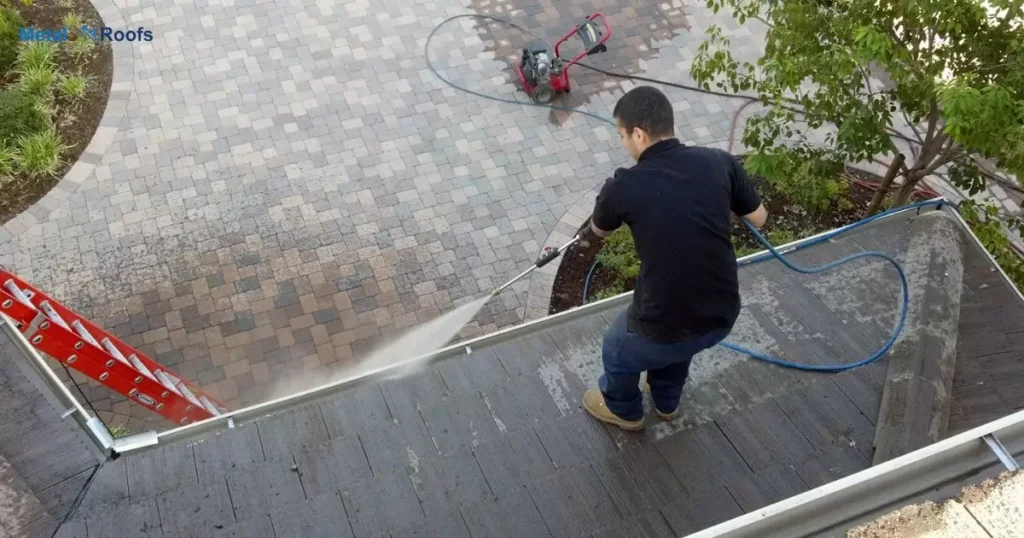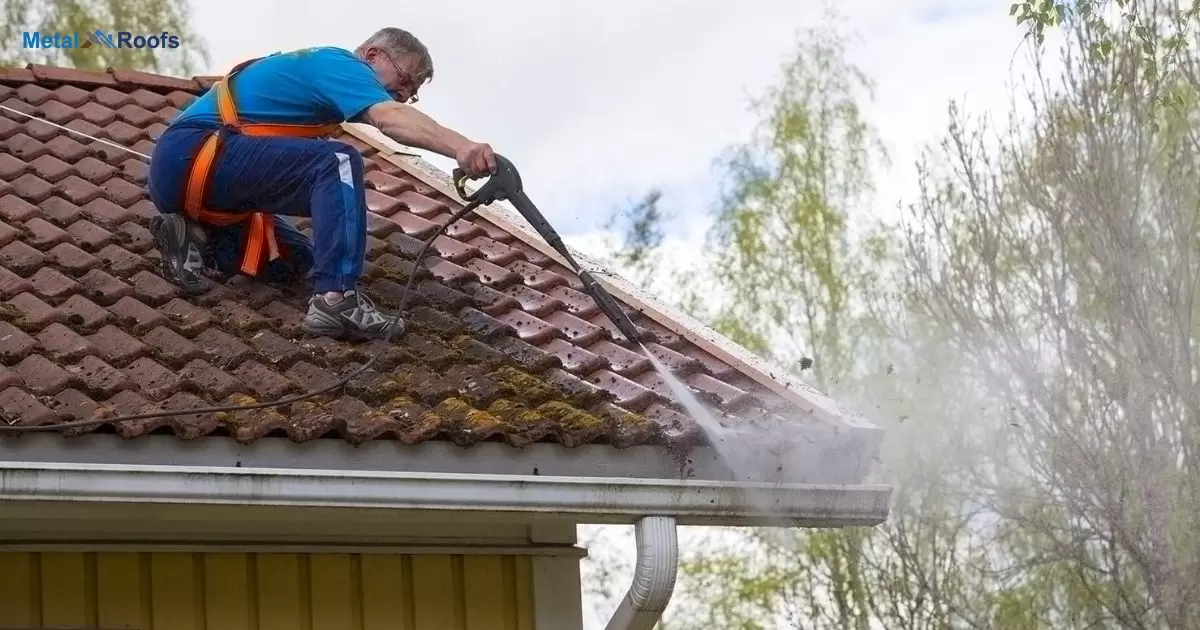Pressure washing cleans metal roofs. Apply detergent to break down grime. Use a pressure washer at low PSI. Rinse thoroughly after washing. Ensure proper drainage and drying. Protect surrounding areas from spray. Hire professionals for complex jobs.
Metal roofs require maintenance. Dirt and debris accumulate over time. Pressure washing offers a solution. It’s an effective cleaning method. can you pressure wash a metal roof? Yes, but approach with caution.
Proper preparation is crucial. Cover nearby areas from spray. Apply roof-safe detergent first. Let it soak and break down the grime. Use a pressure washer next. Start with a low PSI setting. Gradually increase if needed. Maintain a safe distance. Move systematically across the roof. Rinse thoroughly after washing
Key Takeaways
- Prioritize safety by wearing appropriate gear, checking weather conditions, and ensuring ladder stability.
- Use a pressure washer with the correct PSI and a wide-angle nozzle for even distribution.
- Start at the top and work down, maintaining a consistent distance and rinsing thoroughly afterward.
- Understand the type of metal roof you have and follow specific cleaning guidelines to avoid damage.
- Regularly cleaning your metal roof helps maintain its appearance and prolong its lifespan.
Choosing The Right Equipment For Pressure Washing
Choosing the right equipment for pressure washing is key. First, get a pressure washer with 1,500 to 2,500 PSI. This range is safe for metal roofs. Next, use a wide-angle nozzle, like 25 or 40 degrees. This prevents damage and spreads the pressure evenly.
Wear safety gear, like non-slip shoes and goggles. A garden sprayer helps apply the cleaning solution. Use a stable ladder and have someone assist you.
If you have solar panels installed on metal roofs, take extra care around them and ensure they are properly secured before starting the cleaning process. Follow these steps to clean your roof safely and effectively.
Understanding The Type Of Metal Roof
Standing Seam Metal Roofs:
Description: Features vertical panels with raised seams.
Considerations: The seams can be prone to damage if too much pressure is applied directly. Ensure water flow is directed away from seams to avoid water infiltration.
Corrugated Metal Roofs:
Description: Characterized by wavy ridges and valleys.
Considerations: The ridges provide a natural guide for water flow, but the valleys can trap debris. Use gentle pressure to avoid denting the metal.
Metal Shingles:
Description: Designed to look like traditional shingles but made of metal.
Considerations: These can be more delicate than other types of metal roofing. Apply even, broad pressure and avoid focusing on one area to prevent bending or dislodging shingles.
Stone-Coated Steel:
Description: Metal panels coated with stone granules for added texture and durability.
Considerations: High pressure can strip the stone coating. Use a lower pressure setting and a soft brush to avoid damaging the coating.
Safety Precautions For Pressure Washing Metal Roofs

When pressure washing a metal roof, safety is paramount. Here are some precautions to keep in mind:
Wear Protective Gear: Always wear safety goggles, gloves, and non-slip footwear. Consider wearing a long-sleeved shirt and pants to protect your skin from debris and water.
Use a Stable Ladder: Ensure your ladder is sturdy and placed on stable ground. Avoid setting it up on wet or uneven surfaces. Use a ladder stabilizer if necessary.
Check Weather Conditions: Avoid pressure washing during windy or stormy weather as it can be hazardous. Wet surfaces can also increase the risk of slipping.
Inspect the Roof: Before starting, inspect the roof for any loose or damaged areas. Repair or secure them before pressure washing to prevent accidents.
Use the Right Equipment: Use a pressure washer with an appropriate nozzle for metal surfaces. Start with a low-pressure setting and test on a small area to avoid damage.
Maintain Distance: Keep a safe distance from the roof while operating the pressure washer. Stand on the ladder at a comfortable distance to reach the roof without overreaching.
Watch for Electrical Hazards: Be aware of nearby electrical lines or equipment. Keep the pressure washer and extension cords away from water and electrical sources.
Work with a Partner: It’s safer to have someone else present while pressure washing. They can assist with equipment, provide support on the ground, and act in case of an emergency.
Follow Manufacturer’s Instructions: Read and follow the manufacturer’s instructions for the pressure washer and any cleaning solutions used.
Rinse Thoroughly: After pressure washing, rinse the roof thoroughly with clean water to remove any cleaning agents or debris.
Dispose of Waste Properly: Dispose of any waste materials, such as cleaning solutions or debris, in accordance with local regulations.
By following these safety precautions, you can effectively pressure wash a metal roof while minimizing risks to yourself and others.
Common Mistakes To Avoid When Pressure Washing Metal Roofs
- Avoid excessive pressure to prevent damage.
- Use a wide-angle nozzle suitable for metal.
- Pre-clean to avoid pushing debris into crevices.
- Test on a small area first to adjust settings.
- Use gentle cleaners designed for metal.
- Wear safety gear like goggles and gloves.
- Be mindful of surroundings to prevent damage.
- Have a spotter when working on the roof.
- Thoroughly rinse the roof after cleaning.
- Follow manufacturer’s guidelines for equipment and cleaners.
How To Maintain Your Metal Roof After Cleaning?

After cleaning your metal roof, focus on maintenance to keep it in good shape. Regularly inspect for rust or damage, especially around seams and fasteners. Apply a rust treatment if needed to prevent corrosion.
Clear debris like leaves and branches to avoid clogs and water pooling. Check gutters and downspouts for blockages and ensure proper drainage. Trim overhanging branches to prevent damage from falling limbs.
Benefits Of Pressure Washing Metal Roofs
Pressure washing metal roofs offers several benefits:
Efficient Cleaning: Removes dirt, grime, moss, and algae effectively, restoring the roof’s appearance.
Prevents Damage: Regular cleaning prevents build-up that can lead to corrosion, rust, and water leaks.
Enhances Longevity: Maintains the integrity of the roof materials, extending its lifespan.
Improves Energy Efficiency: A clean roof reflects more sunlight, reducing heat absorption and lowering cooling costs.
Preserves Curb Appeal: Enhances the overall look of your property, increasing its value and aesthetic appeal.
Risks To Be Aware Of When Pressure Washing A Metal Roof
When pressure washing a metal roof, it’s crucial to be aware of potential risks. Firstly, using too much pressure can damage the roof’s surface and coatings. Focus on gentle, even cleaning to avoid this problem.
Secondly, slipping and falling are significant risks, especially on wet metal surfaces. Wear non-slip shoes, use a safety harness, and secure ladders properly. Additionally, be mindful of electrical components and avoid spraying them directly.
Power Washing Metal Roof

When power washing a metal roof, prioritize safety. Wear non-slip shoes, safety goggles, and gloves. Check the weather for calm conditions and ensure your ladder is stable.
Select the right pressure washer with 1,500 to 2,500 PSI. Use a wide-angle nozzle to evenly distribute pressure. Begin at the top and work your way down, maintaining a consistent distance from the roof. Rinse thoroughly after washing to remove any residue.
Frequently Asked Questions
Is it safe to pressure wash a metal roof?
Yes, if done correctly with proper safety precautions and equipment.
Can you walk on a metal roof to clean it?
Yes, you can walk on a metal roof to clean it, but use caution and proper safety equipment to prevent accidents.
How do you clean a metal building roof?
You can clean a metal building roof by using a pressure washer with an appropriate PSI and a wide-angle nozzle for even cleaning. Follow safety precautions and rinse thoroughly after washing.
Conclusion
Prioritize wearing protective gear and choosing the right pressure washer with a suitable nozzle. Follow a methodical approach, starting from the top and working downward to ensure thorough cleaning. Rinse the roof thoroughly to remove any residue and maintain its appearance.
Understanding the type of metal roof you have is crucial for effective cleaning. Different roof types may require specific cleaning methods to avoid damage.
Regular maintenance and cleaning not only enhance the roof’s appearance but also prolong its lifespan, ensuring long-term durability and protection for your building.











